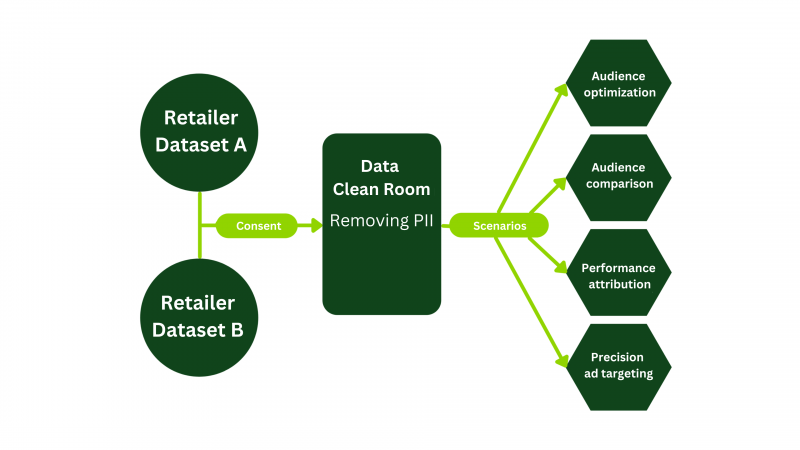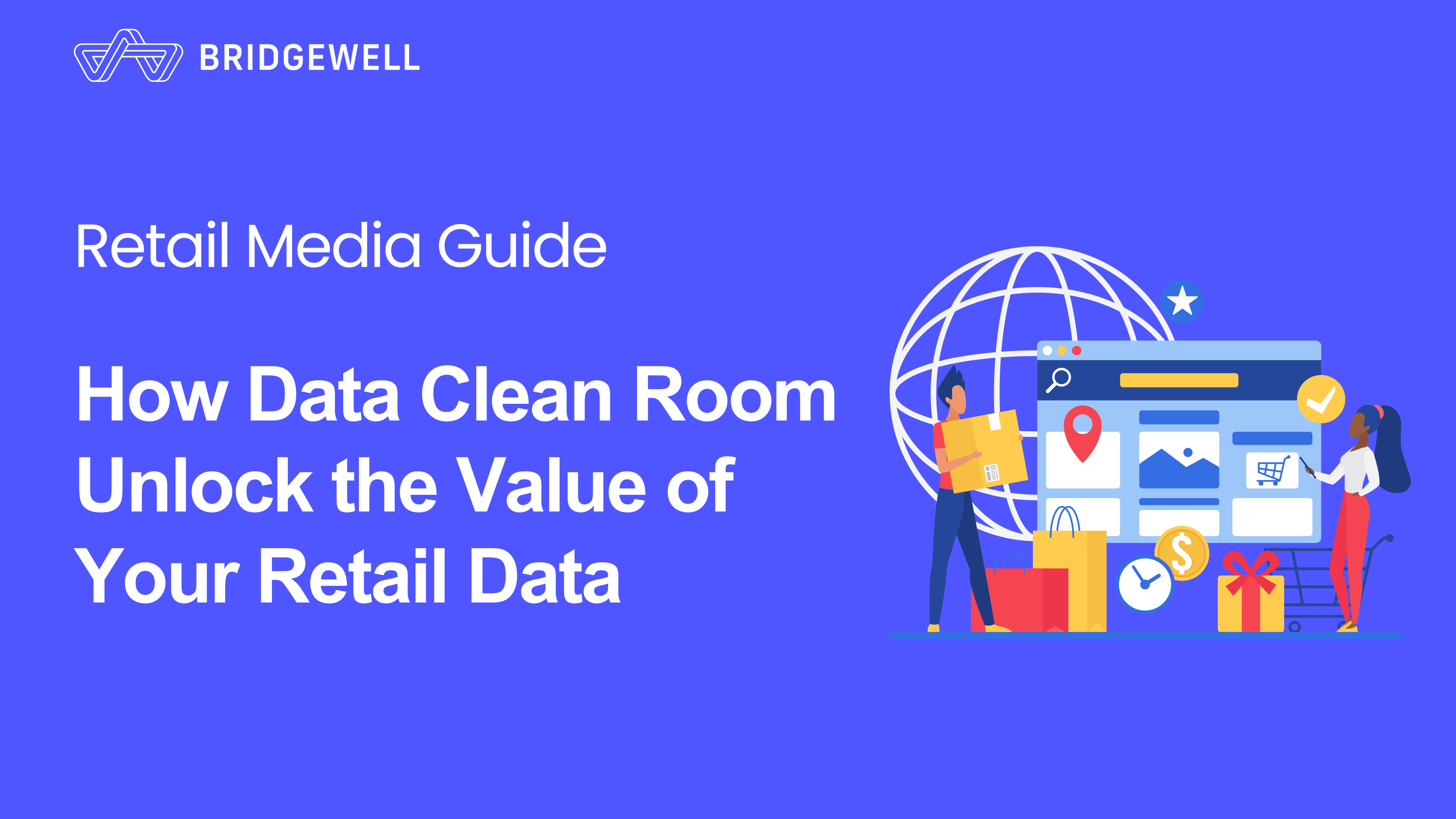In Retail Media Networks (RMN), advertisers need to leverage retailer data, such as consumer purchase history and browsing behavior, to implement precise marketing and advertising strategies. Data Clean Rooms provide a secure data exchange platform, where retailers can input these data for processing, and advertisers can obtain anonymized analysis results without accessing the original data.
–
The Value of Data
In the wave of digital transformation, data has become a core asset for brand marketing. Particularly in Retail Media Networks (RMNs), data drives precise advertising, enabling brands to directly reach their target audiences. The true value of RMN lies in its rich and diverse data sources, which help advertisers gain better insights into consumer behavior trends.
The sharing and usage of data will be key to the success of RMN platforms. However, data owners are generally cautious about sharing data due to privacy and security concerns, such as risks related to personal data breaches. Balancing comprehensive data utilization to generate consumer insights with ensuring data privacy and security is critical for the continued growth of retail media.
–
Key to RMN Success: Rich and Diverse Data Sources
Providing Retailers with New Revenue Streams
For retailers, RMN offers a new profit model that transforms existing traffic data resources into monetizable digital marketing assets. By integrating on-site, offsite, and offline media placements and consumer data, retailers can deliver more precise, consumer-oriented ad experiences. This encourages advertisers to continually invest in retail media, allowing retailers to generate additional revenue from traffic and data usage.
How Can Retailers Enhance Data Value?
The greatest value of RMN for retailers lies in “monetizing traffic data.” As data is made available and used in advertising, retailers can charge data usage fees. The richer the data types and applications, the more RMN can stand out in the overall digital advertising market, encouraging continued investments from advertisers.
Advertisers benefit from better ad returns through more precise exposure and can use rich consumer behavior insights to refine audience analysis and optimize subsequent marketing decisions. Increased investment in retail media by advertisers translates into more brands and products being featured, leading to more consumer spending, which in turn generates more consumer data for retailers to analyze and improve shopping experiences.
Therefore, when retailers and data providers start treating data as an asset (open and share usage), they not only enhance the commercial value of their data but also attract more advertising investments and brands into the RMN ecosystem, creating a win-win situation.
Practical Application Examples
Retailers’ consumer data can reveal purchasing habits, inform advertisers which products are popular, determine peak purchase times, and indicate whether purchases are made online or in-store. Beyond advertising, retail data can also be applied to loyalty programs, providing long-term behavioral data to help advertisers understand consumer preferences and brand loyalty over time.
Thus, it’s not just about short-term purchases driven by ads; through observations of consumer journeys and long-term trends, brands can better understand and cultivate consumers’ long-term contributions, including repeat purchases.
–
Data Privacy and Security
As data becomes increasingly important in marketing and commerce, data privacy and security have become top priorities for retailers and data providers. In RMNs, data sharing and integration are key to enabling precise advertising and personalized marketing strategies. However, this involves commercial secrets and consumer privacy, making companies cautious about opening up their data.
Regulatory Challenges and Compliance Pressure
Data privacy regulations worldwide, such as the EU’s General Data Protection Regulation (GDPR) and the California Consumer Privacy Act (CCPA), have increased the challenges of compliance. Although Taiwan’s current data regulations are not as stringent as those in overseas markets, any company that is a multinational, has overseas operations, or plans to expand internationally will face stricter requirements for data privacy.
Retailers and data providers naturally want to mitigate legal risks arising from potential personal data breaches, which could also affect brand reputation and consumer trust.
Commercial Secrets and Competitive Pressure
Apart from privacy regulations, retailers and data providers are also concerned that sharing data might directly or indirectly expose business secrets, especially if the data falls into the hands of competitors or unauthorized third parties. Ensuring that data is not misused during the integration process is a major technical challenge in promoting data sharing.
Building Trust for Long-Term Benefit
Ensuring data privacy and security is not only about avoiding legal risks but also about establishing a strong trust foundation within the business ecosystem. A secure data-sharing environment allows retailers and data providers to maximize the value of their data assets, attracting more advertisers to join the RMN platform and achieving long-term business benefits.
–
Data Clean Room Applications in Retail Media
In today’s data-driven marketing environment, retailers and data providers often face a major challenge: how to fully utilize their data while ensuring privacy and security. Data Clean Rooms (DCR) are currently the mainstream solution. DCR provides a secure, compliant environment that allows data sharing with partners without the risk of data breaches or privacy issues. Using this technology, data can be deeply analyzed under secure conditions to improve ad targeting, ensuring both privacy protection and continuous data usage revenue for retailers and data providers.
What is a Data Clean Room?
A Data Clean Room (DCR) is a secure data-sharing environment that allows different companies to analyze and collaborate on data without disclosing Personally Identifiable Information (PII). Simply put, a DCR is like a “data safe” where brands, retailers, advertisers, and other parties can securely exchange and analyze data without accessing each other’s detailed data, thereby ensuring privacy and security.
In RMNs, the role of Data Clean Rooms is crucial as they allow advertisers to optimize ads based on precise data, while retailers protect their data assets and provide valuable insights to advertisers.
How Data Clean Rooms Work
The basic operation of a Data Clean Room involves aggregating data from multiple sources for analysis without revealing sensitive personal information. The process can be summarized as follows:
- Data Encryption: Before entering the DCR, all data is encrypted to ensure it cannot be directly read.
- Data Analysis: Once data enters the DCR, each party can analyze the anonymized data to identify insights like purchasing trends and audience behaviors without accessing specific personal information.
- Result Sharing: After analysis, the DCR only outputs processed results, such as consumer behavior patterns or product popularity, without revealing specific personal data. This ensures privacy while providing valuable business insights.
Application of Data Clean Rooms in RMNs

–
Advertisers in RMNs require a large volume of retailer data, such as purchase history and browsing behavior, to implement precise marketing strategies. Data Clean Rooms offer a secure data exchange platform where retailers can process data while advertisers receive anonymized analysis results without accessing the original data. Common DCR use cases in RMNs include:
- Advertising Campaigns: If a customer frequently buys a particular product category (e.g., carbonated drinks), Consumer Packaged Goods (CPG) brands can use this data to target them with complementary products or promotions.
- Audience Segmentation: By analyzing anonymized purchase records and membership data, brands can identify different audience segments and their buying trends and preferences, such as “value shoppers,” “frequent buyers,” or “brand loyalists.”
- Consumer Behavior Analysis: By sharing anonymized transaction data securely, advertisers can better attribute consumer touchpoints to conversions, calculating a reasonable return on ad spend (ROAS).
- Product and Purchase Forecasting: Advertisers can gain deeper insights into retail consumption and forecast demand, optimizing inventory management and reducing stockouts both online and offline.
For example, an advertiser wishing to target a specific audience can match its consumer data with a retailer’s purchasing data in a DCR to identify consumers who bought a particular product, allowing more precise ad targeting. Data sharing in this process is fully anonymized and protected, ensuring both sides receive only the analysis results without viewing each other’s data.
–
Technical Safeguards of Data Clean Rooms
The technical foundation of Data Clean Rooms involves strict data and analytics controls. Data is anonymized before entering the DCR, with all identifiable markers removed. Additionally, DCRs usually feature detailed data usage protocols to ensure that only authorized algorithms or personnel can process the data. All data exchanges, sharing, and analyses are monitored and audited to ensure compliance. Retailers and data providers can ensure that their data is only used for authorized ad placements and market analyses, minimizing the risk of privacy breaches.
The Commercial Value of Data Clean Rooms
The greatest value of Data Clean Rooms lies in making data sharing more secure and reliable, promoting data flow on the RMN platform, and enabling advertisers to fully utilize data for precise targeting. For retailers, DCRs protect data assets while creating new revenue opportunities. Retailers can provide anonymized data for advertiser use, charge for data services, and simultaneously enhance RMN ad effectiveness, attracting more advertisers.
–
How Data Clean Rooms Enhance RMN Data Value
The success of RMNs depends on data diversity and the extent to which data can be used. Advertisers need in-depth insights into consumer behavior patterns, purchasing habits, and preferences. Such insights help them precisely target audiences, improve ad performance, and continually invest in retail media and data.
Enhancing Data Value, Creating New Revenue Streams
Data Clean Rooms not only safeguard data security but also help retailers and data providers fully leverage their data. By collaborating with advertisers, consumption data can be converted into accurate market trend insights, generating data usage fees. This increases data value, creates new advertising revenue streams, and maintains control over data usage, allowing authorized marketing analysis and ad placements that align more closely with business strategies.
More Accurate Marketing Decisions, Strengthened Partnerships
DCRs enable the integration of first-party data in a secure environment, allowing advertisers to better understand consumer behavior and execute more targeted ads. This increases ROI/ROAS and enhances advertiser confidence in collaborating with retail media. When data sharing becomes safer and more valuable, advertisers are more likely to establish long-term partnerships, further enhancing cooperation between retailers and advertisers.
Maintaining Competitive Edge, Attracting More Advertisers
Data-driven digital marketing is the future, and DCRs can increase the value of the retail media ecosystem while safeguarding data privacy. By providing high-quality, valuable data, retailers help advertisers formulate more effective marketing strategies and maintain their competitive edge. As advertisers see the tangible business value of retailer-provided data, retail media and data will become essential components of the digital marketing ecosystem.
Long-Term Impact of Data Sharing and Win-Win Outcomes
Data sharing not only fosters RMN platform growth but also enables retailers and data providers to create new revenue models. When data becomes a valuable asset, retailers can attract more advertisers to the RMN platform through data sharing, further expanding RMN’s influence. Advertisers benefit from more accurate data, increased marketing ROI, and a greater willingness to invest in RMN advertising.
In the long run, data sharing will become a vital part of the RMN ecosystem, creating a win-win situation. Retailers gain extra revenue from data and advertising, while advertisers obtain precise market insights and effective advertising results. This mutually beneficial model will drive RMN’s continued growth in the data-driven digital marketing market.
